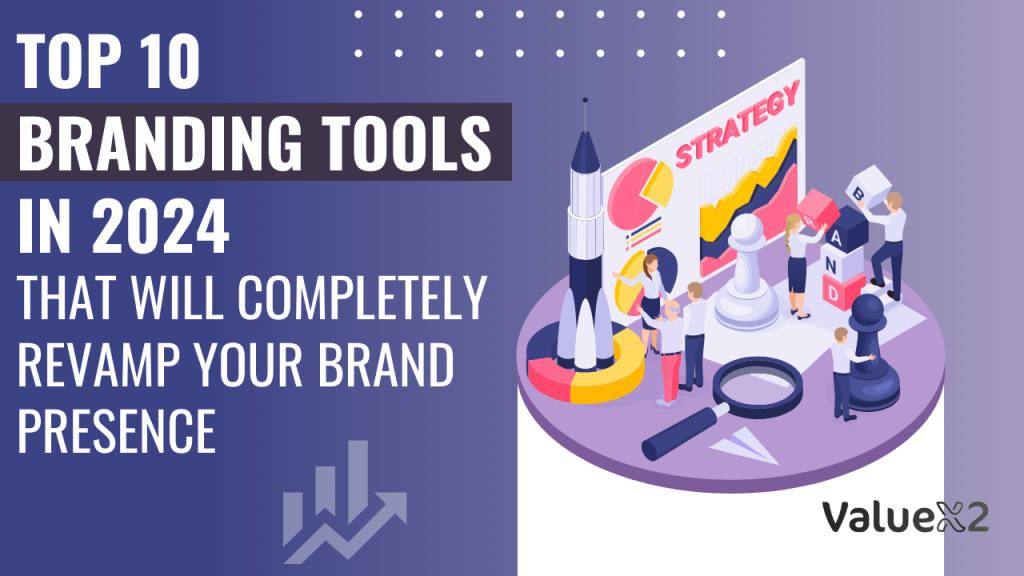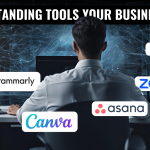Here’s the list of the top 10 marketing tools for businesses that can boost your brand presence.

A strong brand identity is now needed in today’s highly competitive world. However, creating a unified and memorable brand experience can take time and effort. Do not be alarmed! You may strengthen your brand’s visibility and establish a more meaningful connection with your audience by using the carefully picked list of the top 10 branding tools for 2024.
This post contains the top brand revamping software applications and tools that are best for use in 2024. Along with the details of these best branding tools, we have also highlighted their pros and cons to give you a transparent view of each tool mentioned in this list.
But, before we commence, a quick question?
Are you a product manager, or do you work for a firm that acknowledges agility? Agile methodologies have become paramount today as most organizations are abolishing traditional methods. You will require an Agile certification to provide that extra value for your firms. This certification raises your chances of a promotion or even landing a job. ValueX2 allows you to get Agility certifications, and to your advantage, our Agility Certifications are globally recognized and can be used anywhere. So, if you’re thinking of upskilling with Lean-Agile methodologies, you can check out Valuex2.com’s scrum and agility courses.
Now, let’s learn about the best branding tools that you can use in 2024!
Building Your Brand Foundation
1. Semrush
Semrush offers a full suite of tools for digital marketing that goes beyond SEO. Acquire insightful knowledge about your web presence, examine the tactics of rivals, and gauge the effectiveness of your material. Find areas of weakness and opportunities to improve your brand messaging and rank higher in search results than the competition.
Pros: Provides competitive research, content performance tracking, in-depth SEO analysis, and an intuitive user interface.
Cons: It may be costly for smaller companies; extensive data may be too much for novices to handle; mastery of all features needs commitment.
2. Adobe Illustrator
With Adobe Illustrator, the industry standard for vector graphics, you can create beautiful logos that go from business cards to billboards with ease. Accurate instruments and a wide range of functions enable complex designs to blend in with typefaces, colour schemes, and brand components so your logo fully captures your brand identity.
Pros: Adaptable workspace, superior scalability, sophisticated design tools, and integration with other Adobe programs.
Cons: Higher learning curve for novices; resource-intensive for intricate designs; possibly unnecessary for straightforward logos.
3. Frontify
Frontify centralizes all of your brand’s assets, including colour schemes, logos, and extensive style manuals. Work together with your team to guarantee brand coherence on all platforms. Maintaining an updated and visually attractive brand identity is made simple with Frontify’s brand management solutions.
Pros: Centralized brand asset storage, an easy-to-use interface, rules for captivating multimedia content, and compatibility with well-known tools.
Cons: Less functionality in more affordable plans, a small learning curve, and sporadically reported user-generated technical issues.
Design and Content Creation Made Easy
4. Google Fonts
With its enormous selection of free typefaces, Google typefaces can meet a wide range of branding requirements. Choose typefaces that are in line with your brand language and use them with ease. Your chosen typefaces will blend in perfectly with your overall brand look thanks to the user-friendly interface, which makes previewing and selecting simple.
Pros: Strong collection of free fonts, easy-to-use interface, straightforward website integration, and regular font updates.
Cons: Many popular fonts are used excessively; excessive font loading may have an adverse effect on efficiency; some fonts need more sophisticated capabilities.
5. Coolors
For vibrant and harmonious colour palettes, look no further than Coolors. This intuitive tool allows for the quick generation, refinement, and export of colour schemes. With a simple click, explore a variety of options, fine-tune them to match your brand identity, and download palettes in various formats.
Pros: User-friendly interface, diverse colour combinations, multiple export options, integration with design tools, mobile app available.
Cons: Overwhelming options for some users, occasional technical issues reported.
6. Canva
Canva enables both novices and experts in design to produce visually striking content for social networking. Content development is streamlined by a wealth of templates designed for various social media sites. The user-friendly drag-and-drop interface and extensive element library make creating dependable and captivating social media content effortless.
Pros: Easy drag-and-drop interface, extensive library of elements and templates, compatibility for several devices.
Cons: The platform may slow down with sophisticated designs and has limited free features.
Elevating Brand Communication
7. Buffer
Buffer makes managing, publishing, and scheduling social media content easier on a variety of platforms. Remain constant in your presence while successfully interacting with your audience. Content creation and curation, performance analysis, and follower interaction are all made easier with Buffer. Perfect for companies looking to connect with their target market without becoming overstimulated.
Pros: Easy-to-use interface, content performance data, collaborative team tools, and multi-platform posting from a single dashboard.
Cons: Not all platforms are supported; some sites do not allow direct posting; subscriptions are required for additional capabilities.
8. Wistia
Wistia is a dedicated platform that is made just for branding videos. Produce polished videos, host them with ease, and learn insightful things about how viewers behave. Wistia makes sure your videos are visually consistent with your brand, effectively engages viewers, and offers useful analytics to help you improve your video marketing strategy.
Pros: Personalized video content for brand coherence, comprehensive analysis of viewer behaviour and seamless cross-platform playing.
Cons: Limited storage on basic plans, difficulties exporting movies to some social media networks, learning curve for new users.
Building Brand Trust and Advocacy
9. HubSpot Email Signature Generator
The top branding tool for businesses is HubSpot. You can create consistent, polished signatures that represent your brand identity with their free email signature generator. Ensure that every email supports professionalism and brand recognition by skillfully integrating social media connections, calls to action (CTAs), and logos.
Pros: Easy-to-use interface, fully free tool, adaptable email signatures, smooth connection with most email clients.
Cons: Less creative flexibility than with premium email branding tools; formatting problems may arise based on the email client being used.
10. Wix
With Wix, you can design and modify websites without needing to have coding expertise. A multitude of design templates and drag-and-drop functionalities accommodate many branding styles, ranging from e-commerce platforms to expert portfolios. Wix provides the tools to create a website that embodies your brand identity and appeals to your target audience, whether you’re building a new online presence for your business or redesigning an old one.
Pros: Mobile-friendly websites, an extensive selection of themes and configurable designs, easy drag-and-drop interface, and interfaces with apps and plugins for increased functionality.
Cons: Transitioning a Wix site to a different platform can take time, and experienced users may see limitations in the design versatility.
With the help of the latest and best branding tools, you can speed up the process and establish a strong brand identity. Moreover, you create a captivating online presence that attracts and engages your target audience.

Bhavna is an Agile Coach and Consultant with over a decade of experience in advisory, corporate finance, IT assurance, and operations at Big 4 and within the industry in the UK and India. She has recently been the CEO of a start-up where she implemented agile practices within HR, Marketing, and Product teams.
She is also a SAFe® Practice Consultant (SPC) and authorized instructor for ICAgile Agility in HR (ICP-AHR), Agility in Marketing (ICP-MKG), and Business Agility Foundations (ICP – BAF) training courses. She provides training for agile transformation to corporate, public, and private batches, as well as consulting for enterprise agile transformation.






